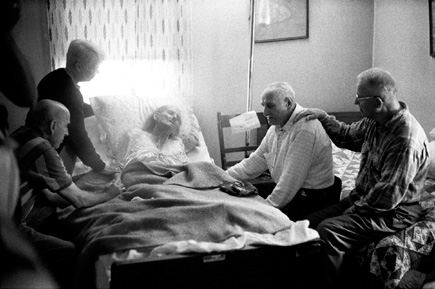Ed Kashi; Recording The Human Experience Page 2
"I was under the mistaken notion that if you get an assignment from Business Week you get an assignment from Time, then from Life, then National Geographic. But that was not how it worked and it wasn't until the late '80s that I began to do anything of real significance," he recalls. "It took that time for me to find out who I was and what really mattered.
"This is an incredibly tough profession and it's always a challenge to get compensated for the work I want to do as opposed to just being a hired gun," Kashi says. "Too, with the political and economic structure that is taking place in the media and in America at large, there is definitely less opportunity for photojournalists, especially as a free-lancer for magazines. There is not a lot of opportunity to work on serious, important subjects because it is often hard to get these things financed and published."
 |
|
|
Talking Eyes Media
What Kashi and his wife, Julie Winokur, have done is to establish a nonprofit
educational, multimedia organization called Talking Eyes Media (www.talkingeyesmedia.org)
to find alternative funding to facilitate the work he is doing, the things he
feels are important for the world to know about. He believes in the old adage,
"If you build it they will come," and he is determined to get his
message out, to tell his stories.
"We need to bear witness to what is happening in the world and there is
so much more going on than what we get to see," he says. "I try
to concentrate on people's daily life and how this war is affecting them.
It is important to do this work whether you are paid initially for it or not.
Then the photographer must look to resell his work all over the world. This
is the crux of surviving as a photojournalist today."
So far Kashi has been fortunate. He has received numerous awards and his work
has appeared in National Geographic, New York Times Magazine, Newsweek, Aperture,
Fortune, and many other publications worldwide.
 |
|
|
For the past year Kashi has been working digitally, using the Canon EOS 20D.
"I love the workflow it creates," he says. "There are aspects
of shooting digitally that are quite empowering, like the immediate feedback
at the end of the day, particularly when working on a long-term project. I can
better see what I am getting and understand what's working and what is
not as well as being able to caption and keyword the work seamlessly. Given
the kind of work I do, my archives are essential on every level, from the mundane
aspect of just making a living to how I can interpret and organize my work over
a lifetime.
"Every Photoshop file is this complete and perfect file of information.
As a photojournalist, a storyteller, for me it has everything a viewer, editor,
or photo researcher needs to work with in a thoughtful and intelligent way.
"The quality at this point is nearly as good as film and I have exhibited
digital images up to 24x36" and the prints are beautiful."
To learn more about Ed Kashi, visit his website at: www.edkashi.com.
- Log in or register to post comments

































